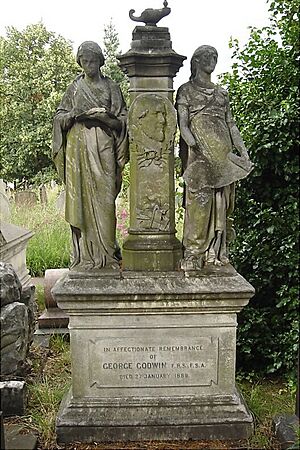George Godwin facts for kids
George Godwin (born January 28, 1813 – died January 27, 1888) was an important British architect, journalist, and the editor of a famous magazine called The Builder. He played a big role in improving cities and helping people.
Contents
Early Life and Career
George Godwin was one of nine children. His father, George Godwin senior, was also an architect. George learned his skills at his father's architecture office in Kensington, London. Later, he started his own business there with his brother, Henry.
George was very interested in the history of architecture. His friend, John Britton, who studied old things, encouraged him. George wrote several books, including The Churches of London (1839). He also wrote about special marks used by masons (stone workers) and the Gothic style of building. He was also interested in new building materials, like concrete, and wrote about its use in 1836.
He quickly became a member of important groups like the Royal Institute of British Architects and the Society of Antiquaries of London. He also became a Fellow of the Royal Society, which is a big honor for scientists. In 1851, he helped start the Royal Architectural Museum.
Leading The Builder Magazine
The Builder magazine first started in 1842. In 1844, George Godwin became its third editor. He immediately made the magazine cover many more topics. It wasn't just about new buildings and architecture anymore. He added articles about history, archaeology (studying old civilizations), art, sanitation (public health), and social issues. The magazine described itself as "An illustrated weekly magazine for the architect, engineer, constructor, sanitary reformer, and art lover."
By covering more topics, the magazine became popular with many different people, not just those in the construction business. George Godwin used the magazine to campaign for better living conditions for working-class people. He wrote a lot about slums (poor, crowded areas) and published his articles as books to encourage change. He strongly supported the creation of public baths and wash-houses, and charitable housing trusts to provide affordable homes. He also promoted the design of pavilion-style hospitals, which were thought to be healthier.
In 1881, George Godwin created the Godwin Bursary. This was a yearly prize given by the Royal Institute of British Architects. It helped young British architects travel outside Great Britain to learn about new building techniques. Winners had to spend at least five weeks in a country of their choice and then write reports about what they learned. The first five winners all chose to go to the United States.
George Godwin edited The Builder until 1883. The magazine was later renamed Building in 1966 and is still published today.
Other Architectural Projects
Even while he was editing The Builder, George Godwin continued to work as an architect in his family's business. He designed churches, homes, and public buildings. Some of his notable works include:
- Redcliffe Square, Kensington
- The Boltons, Kensington
- St Mary's Church, The Boltons
- Elm Park Gardens, Chelsea
- St Luke's Church, Kensington
He also helped restore important churches like St Mary Redcliffe in Bristol and St Mary's in Ware. George Godwin was largely responsible for designing large parts of South Kensington and Earl's Court. This included five public houses, one of which is now the Finborough Theatre.
From 1853 to 1874, Godwin also worked as a district surveyor for south Islington. This meant he was responsible for checking buildings in that area. In 1884, he gave a report to the Royal Commission, a special group that made recommendations for improving housing for working-class people.
Besides his architectural work, George Godwin also wrote plays and helped start the Art Union of London, which promoted art.
Death and Legacy
George Godwin passed away on January 27, 1888, in Kensington. He was buried in Brompton Cemetery in London. His memorial is easy to spot because of its special design. It has a portrait of him and is topped with statues representing Faith and Charity. This monument is considered a Grade II listed building, meaning it's historically important. After his death, his large art collection was sold at Christie's in London on April 12, 1888.
Images for kids



